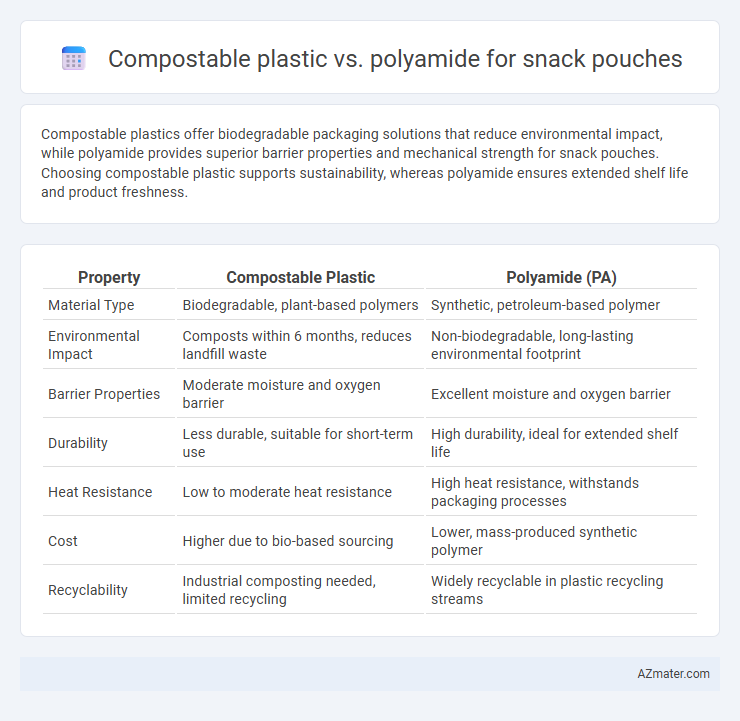Compostable plastics offer biodegradable packaging solutions that reduce environmental impact, while polyamide provides superior barrier properties and mechanical strength for snack pouches. Choosing compostable plastic supports sustainability, whereas polyamide ensures extended shelf life and product freshness.
Table of Comparison
| Property | Compostable Plastic | Polyamide (PA) |
|---|---|---|
| Material Type | Biodegradable, plant-based polymers | Synthetic, petroleum-based polymer |
| Environmental Impact | Composts within 6 months, reduces landfill waste | Non-biodegradable, long-lasting environmental footprint |
| Barrier Properties | Moderate moisture and oxygen barrier | Excellent moisture and oxygen barrier |
| Durability | Less durable, suitable for short-term use | High durability, ideal for extended shelf life |
| Heat Resistance | Low to moderate heat resistance | High heat resistance, withstands packaging processes |
| Cost | Higher due to bio-based sourcing | Lower, mass-produced synthetic polymer |
| Recyclability | Industrial composting needed, limited recycling | Widely recyclable in plastic recycling streams |
Introduction to Snack Pouch Packaging Materials
Snack pouch packaging materials predominantly include compostable plastics and polyamide films, each offering distinct functional benefits. Compostable plastics provide eco-friendly degradation under industrial composting conditions, aligning with sustainability goals in food packaging. Polyamide films excel in barrier properties against oxygen and moisture, ensuring extended shelf life and freshness for snacks.
Overview of Compostable Plastics
Compostable plastics used in snack pouches are primarily derived from renewable resources like cornstarch or sugarcane, designed to break down into non-toxic components under industrial composting conditions within 90 to 180 days. These materials, such as polylactic acid (PLA) and polybutylene adipate terephthalate (PBAT), offer sustainable alternatives to traditional polyamide films by reducing environmental impact through biodegradability. Despite their eco-friendly nature, compostable plastics require specific composting facilities to decompose effectively, limiting their performance in home compost setups compared to the durability and barrier properties of polyamide.
Understanding Polyamide (Nylon) in Packaging
Polyamide (Nylon) offers exceptional barrier properties, mechanical strength, and flexibility, making it a preferred material for snack pouches that require extended shelf life and product protection. Unlike compostable plastic, polyamide is not biodegradable but provides superior resistance to oxygen, moisture, and heat, which is crucial for maintaining snack freshness. Its compatibility with multilayer packaging structures enhances durability and prevents contamination, though it presents challenges in sustainability compared to compostable alternatives.
Environmental Impact: Compostable Plastic vs Polyamide
Compostable plastics used in snack pouches significantly reduce landfill waste by breaking down into non-toxic components within industrial composting facilities, whereas polyamide, a synthetic polymer, persists in the environment for decades due to its resistance to biodegradation. Lifecycle assessments reveal compostable plastics lower greenhouse gas emissions and dependency on fossil fuels compared to polyamide, which involves energy-intensive production and contributes to microplastic pollution. Transitioning to compostable materials in flexible packaging aligns with circular economy goals by promoting resource recovery and minimizing ecological footprint.
Barrier Properties: Oxygen and Moisture Protection
Compostable plastics for snack pouches typically exhibit moderate oxygen and moisture barrier properties, often requiring additional coatings to meet industry standards. Polyamide (nylon) offers superior oxygen and moisture barrier performance, enhancing product shelf life and freshness by effectively preventing gas and vapor transmission. While polyamide excels in barrier protection, compostable plastics provide an eco-friendly alternative with biodegradability, though with generally lower inherent barrier efficiency.
Biodegradability and End-of-Life Options
Compostable plastics used in snack pouches typically break down within months under industrial composting conditions, leaving no toxic residues, making them an eco-friendly choice compared to polyamide. Polyamide, while offering excellent barrier properties and durability, is not biodegradable and usually ends up in landfills or requires energy-intensive recycling processes. The end-of-life options for compostable plastics emphasize biodegradability and home or industrial composting, whereas polyamide's disposal relies heavily on mechanical recycling or incineration with energy recovery.
Food Safety and Regulatory Compliance
Compostable plastics used in snack pouches must comply with stringent food safety standards such as FDA 21 CFR and EU Regulation 10/2011 to ensure no harmful substances migrate into food products. Polyamide films, known for excellent barrier properties, meet rigorous regulatory requirements like EFSA and FDA approvals, providing superior protection against oxygen and moisture, thus extending shelf life. Both materials require comprehensive migration testing and certification to guarantee food contact safety and alignment with international compliance frameworks.
Cost Comparison and Economic Feasibility
Compostable plastic snack pouches generally incur higher material and processing costs compared to polyamide, which benefits from established production economies of scale and lower raw material expenses. The economic feasibility of compostable plastics hinges on rising environmental regulations and consumer demand supporting premium pricing, while polyamide remains more cost-effective for mass-market applications due to its durability and well-developed supply chains. Investment in compostable technology and increased production volumes could reduce costs over time, but current market dynamics favor polyamide for cost-conscious manufacturers.
Consumer Perception and Market Trends
Consumers increasingly favor snack pouches made from compostable plastics due to growing environmental awareness and demand for sustainable packaging solutions. Market trends reveal a shift towards bioplastics that offer effective barrier properties comparable to polyamide, while reducing carbon footprints and enhancing brand reputation. Innovative compostable materials now challenge traditional polyamide pouches by aligning with circular economy principles and meeting regulatory pressures on single-use plastics.
Future Prospects in Sustainable Snack Packaging
Compostable plastics offer promising potential for sustainable snack packaging due to their biodegradability and reduced environmental impact compared to traditional materials. Polyamide, valued for its strong barrier properties and durability, presents challenges in recyclability and end-of-life management, which may limit its future in eco-friendly applications. Advances in biodegradable polyamide alternatives and enhanced compostable plastic formulations are driving innovation towards more sustainable, high-performance snack pouches.

Infographic: Compostable plastic vs Polyamide for Snack pouch
 azmater.com
azmater.com